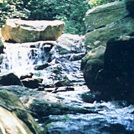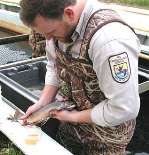Gulf of Mexico's hypoxic zone is predicted to be larger than average this year, due to extreme flooding of the Mississippi River this spring, according to an annual forecast by a team of NOAA-supported scientists.
A new study from biology researchers at Baylor University and the University of Maryland-Baltimore has found that there are consistent and widespread declines in stream biodiversity at lower levels of urban development more damaging than what was previously believed.
Melinda Daniels, associate professor of geography, and Keith Gido, associate professor of biology, are collaborating on a project that involves habitat and fish sampling on the Kansas River, which stretches across northeast Kansas.
Tests of a new antibody-based “biosensor” developed by researchers at the Virginia Institute of Marine Science show that it can detect marine pollutants like oil much faster and more cheaply than current technologies. The device is small and sturdy enough to be used from a boat.
The draft technical document includes an overview of key concepts, examples of assessments of healthy watershed components, and an integrated assessment framework for identifying healthy watersheds.

The new plan should control the Delaware River's salt line and thereby protect aquatic life and drinking water supply that is shared with New Jersey, Delaware, and Pennsylvania.
The funds will go toward improving water, wastewater, and stormwater infrastructure as well as watershed, landfill, and recycling projects.

Stephen R. Carpenter wins Stockholm Water Prize; WEF and IWA name water champions; WaterSense and American Water partner on PSAs.
Using reverse osmosis technology, the underground coal mining company will build an advanced water treatment plant to remove chloride.

With SUNY, the universities will monitor temporal trends in bioaccumulative chemicals in the Great Lakes using top predator fish as biomonitors.
The Rangia clam may take on a new role if studies at Southeastern Louisiana University determine the organism can actually contribute to helping clean oil-polluted waters.
The inaugural prize will be presented in May to city, state, private, and educational groups.
Following more than 50 listening sessions with local communities, the federal government has devised a plan to support community-based conservation and recreation in the "great outdoors."

The rule provides a collaborative and science-based framework for creating land management plans that would support ecological sustainability and contribute to rural job opportunities.
EPA has disapproved Vermont’s 2002 water quality plan that set phosphorus targets for discharges into Lake Champlain.
Usibelli Coal Mine Inc., owner of an open-pit coal mine near Healy in Alaska’s central interior, has signed a consent agreement and final order that resolves water permit violations and numerous unpermitted discharges.
Twenty-nine legislators supported bills in the House and Senate that would remove some authority from the Department of Ecology and set up a new water commission.
The agency has funding available to support demonstration; pre-proposals are due by March 8.
The free webcast on "Nitrogen and Phosphorus Pollution and Harmful Algal Blooms in Lakes” is scheduled for Jan. 26.
EPA will use its authority under the Clean Water Act to halt the proposed disposal of mining waste in streams at the Mingo-Logan Coal Company’s Spruce No. 1 coal mine.